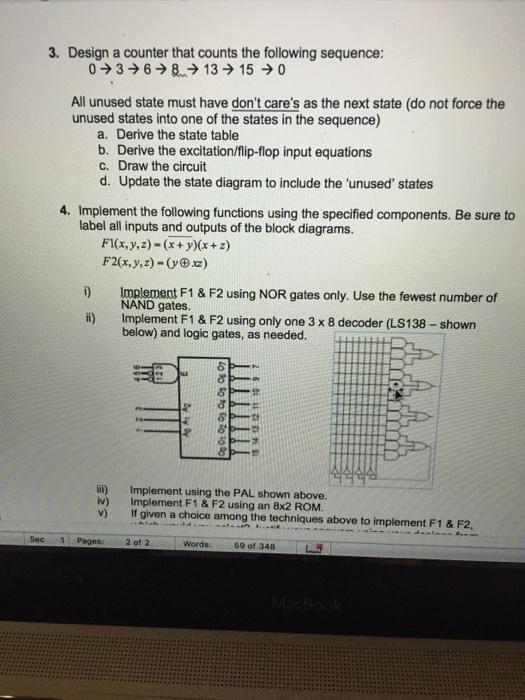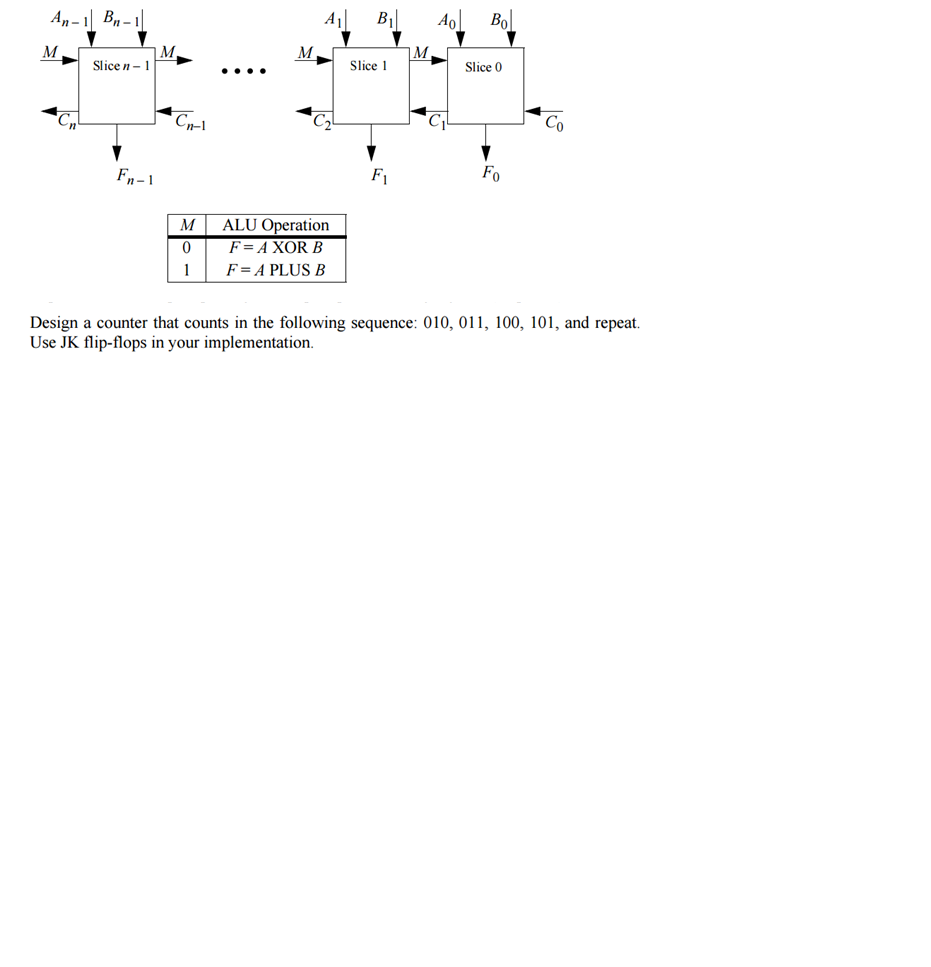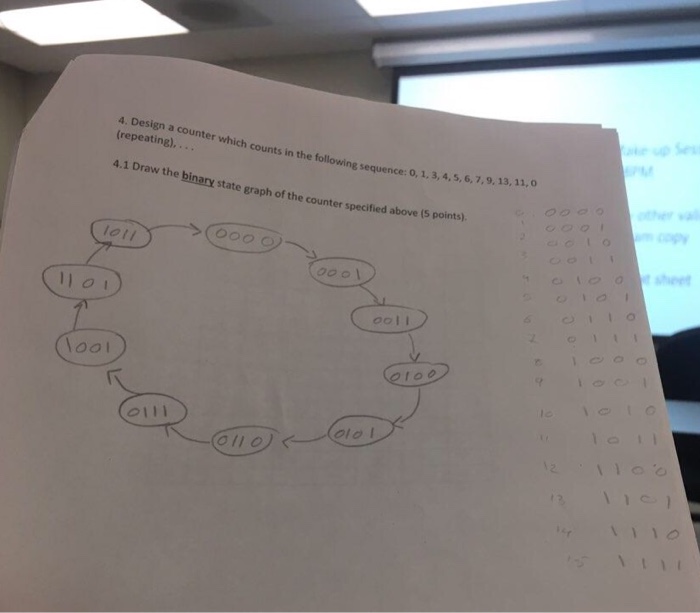1a using JK flip flops 1b using T flip flops 1c using D flip flops 2. Connect J and K inputs to logical 1.

Solved Design A Counter That Counts The Following Sequence Chegg Com
Design a counter with T flipflops that goes through the following binary repeated se- quence.

. Videos you watch may be added to. Explanation For given sequence state transition diagram as following below. 0100 1111 1110 1010 1011 11010110 0010 0111 0011 0101 0000 0001 1100 1000 1001 after that it goes back to 0100 a Make the next state table for this counter.
If playback doesnt begin shortly try restarting your device. 0 rightarrow 3 rightarrow 8 rightarrow 13 rightarrow 15 rightarrow 0 All unused state must have dont cares as the next state do not force the unused states into one of the states in the sequence a. Show that when binary states 010 an.
Using JK flip flop. Connect Q1 to clock 2. This video is the first of three videos showing how to design a counter with an arbitrary sequence using JK flip flops.
Write the excitation table. Design a 2-bit counter that counts the following counting sequence using a T flip-flop and a JK flip-flop. Connect the two Q terminals to outputs 1 and 2.
Design a counter that counts the following sequence. Draw the state diagram. Solution for To design a counter which count in the following sequence 01357 by using T-FF the input of T-FFs are.
This is a constant logical 0. If E is low the counter stays in the current count value. The count sequence is 7-3-1-2-5-4-6.
Problem Design synchronous counter for sequence. 943 Design of a Synchronous Modulus-Six Counter Using SR Flip-Flop The modulus six counter will count 0 2 3 6 5 and 1 and repeat the sequence. Design a counter that counts the following sequence of 2-3-1-0 and repeat.
Design a counter that counts the following sequence. Modify your design in question 1a so that the circuit works according to the following function table X Y F 0 0 Clear 0 1 No Change 1 0 Parallel Loading 1 1 Count 3. Design a counter with the following repeated binary sequence.
Engineering Electrical Engineering QA Library bläi 9 Q11To design a counter which count in the following sequence 763501 by using SR- FF the input of SR-FFs are SAABCABC RA. Design a counter that counts in the following sequence. The state table is as shown in Table 31.
Design a counter that counts the following sequence. Draw the circuit d. Also there is an enable input E which should be high for the counter to count.
B Design a digital circuit using D flip flops and minimum circuit components show complete working of Kmaps. The count stops when C 0. 0 1 2 3 4 5 6.
How do you design a three-bit counter that counts in the sequence 0 2 4 6 0. Design a counter that counts in the following sequence It is less complicated than uncomplicated to create exceptional nail artwork for short nailsAll you must do would be to introduce some glitter in. Let the type of flip-flops be RS flip-flops.
Please include truth table and k-maps. 1 4 6 7 1 4 6 7. 0 4 2 1 6.
Design A Counter That Counts In The Following Sequence. The counter is enabled by the input C. Design a counter with the following binary sequence 0 1 3 7 6 4 and represent using T flip flop.
Written 52 years ago by akamitkhareak 370. The count is to be represented directly by the contents of three D flip-flops. These values will be displayed on a seven-segment display like the one used in Lab 3.
Number of flip flops. The truth table of a modulus six. Since it is a 3-bit counter the number of flip-flops required is three.
Table1 shows the excitation table for T flip flop. Derive the state table b. Use a two bit counter.
This modulus six counter requires three SR flip-flops for the design. 0 1 3 7 6 4. 0 1 3 4 5 7 0 using T flip-flop.
Solution for Design an Asynchronous counter to count the following sequence using T FF. Let the three flip-flops be A B and C. Use JK flip-flops given to you at the start of the semester.
Design a counter which counts in the following sequence. Connect the clock input to Clock 1. You dont use the 1 bit.
Simulate your design using SimUaid. 0100 0000 0010 0110 0111. 000 100 010 001 110 111 repeat 000.
Table2 shows the circuit excitation table. The count sequence is 7-3-1-2-5-4-6. Electrical Engineering questions and answers.
011 we have to use three T flip flops. This video is the first of three videos showing how to design a counter with an arbitrary sequence using JK flip flops. Use the T flip-flop for MSB and the JK flip-flop for LSB for each count value.
Design a counter which counts 0 4 8 2 6 and repeats using. The next-state from all unused states are undefined. Use D flip-flops and NAND gates.
Since the highest state is 6 ie. Derive the excitationflip-flop input equations c. Design a counter with the following repeated binary sequence.

Design Counter For Given Sequence Geeksforgeeks

Solved Design A Counter That Counts In The Following Chegg Com

Solved Consider A Counter That Counts In The Following Chegg Com

Design Counter For Given Sequence Geeksforgeeks

Design A Counter With An Arbitrary Sequence 2 3 Youtube

Q 6 24 Design A Counter With T Flip Flops That Goes Through The Following Binary Repeated Sequence Youtube

Solved 4 Design A Counter Which Counts In The Following Chegg Com
How To Design A Counter With The Following Binary Sequence 0 3 5 6 4 2 And Repeat Quora
0 comments
Post a Comment